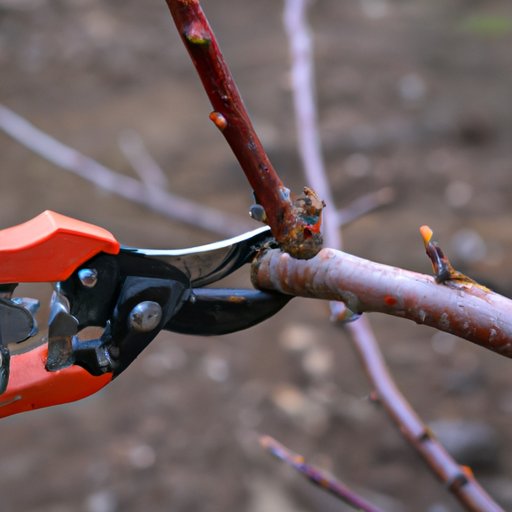
I. Introduction
Peach trees are a wonderful addition to any garden, providing delicious fruit in the summer months. However, to ensure your tree is healthy and productive, pruning is an essential task. Pruning removes dead, diseased, and excess growth, promoting proper air flow and sun exposure. In this article, we will discuss how to prune a peach tree step-by-step, the different pruning techniques, common pruning mistakes, and the tools needed for the job.
II. Step-by-Step Guide to Pruning a Peach Tree
The best time to prune a peach tree is in late winter or early spring before new growth appears. Before you begin, make sure your tools are clean and sharp, and wear protective clothing, including gloves and eye protection.
To get started on pruning your peach tree, first remove any dead, diseased, or damaged wood. These sections can be identified by discolored bark, cracks, or holes. Cut back to healthy wood, leaving a smooth surface. Next, remove water sprouts, which are the small, fast-growing branches that emerge from the base of the tree or along larger branches. These shoots do not produce fruit and can weaken the tree.
To maintain the right shape for the tree, cut back old branches by one-third of their length. Make sure to leave a few inches of new growth. Remove any growth that is crossing or rubbing against other branches. Finally, thin out any excess growth on the interior of the tree to allow proper airflow and sunlight.
When disposing of pruned materials, do not leave them lying around the tree as they can harbor insects and diseases. Rather, put them in a trash bag or compost them.
III. Different Pruning Techniques for a Peach Tree
There are three main pruning techniques for a peach tree: open vase pruning, central leader pruning, and modified central leader pruning.
Open vase pruning involves removing the central leader, or main trunk, of the tree, and the primary branches are trained to grow at an angle away from the center of the tree. This method promotes air flow and sunlight penetration and is often used for dwarf or semi-dwarf peach trees.
Central leader pruning involves keeping the central leader intact and focusing on developing a main trunk with evenly spaced lateral branches. This method is often used for standard-sized peach trees.
Modified central leader pruning is a combination of the other two techniques, allowing for both a central leader and open center. This method is often used for larger peach trees.
The technique you choose depends on your tree’s size and planting location, as well as your personal preference. Each method has its benefits and drawbacks, so it’s important to research and choose the right one for your situation.
IV. Video Tutorial on Pruning a Peach Tree
If you’re a visual learner, a video tutorial can be a great way to learn the proper technique for pruning a peach tree. Check out this video tutorial for step-by-step instructions on how to prune a peach tree.
Visual instruction is especially helpful for beginners who are unsure of how to proceed with their pruning. The tutorial covers everything from the right tools to use to the proper cuts to make when pruning.
V. Common Pruning Mistakes for a Peach Tree
While pruning can greatly benefit your peach tree, it’s important to avoid common mistakes to prevent damage. Over-pruning is a common mistake that can harm your tree by removing too much healthy growth. Pruning at the wrong time of year can also damage the tree, as it can cause excessive bleeding or stimulate unwanted growth.
Not sanitizing your tools before pruning can also lead to the spread of disease or pests. Before pruning, wipe your tools with rubbing alcohol or a solution of one-part bleach to nine-parts water.
Finally, avoid damaging the tree by making proper cuts close to the branch collar, which is the swollen area at the base of the branch. Do not leave stubs, which can be an entrance point for pests and disease.
VI. Tools for Pruning a Peach Tree
To effectively prune a peach tree, it’s essential to have the right tools. We recommend using hand pruners for smaller branches, loppers for larger branches, and a pruning saw for the thickest branches. Make sure your tools are clean, sharp, and well-oiled before pruning. Wear gloves and eye protection, as well.
When using hand pruners or loppers, position the cutting blade toward the side of the branch you intend to keep, making a clean cut at a slight angle. When using a pruning saw, make several cuts starting from the bottom of the branch, working your way up, to prevent tearing and splintering.
VII. Conclusion
Pruning a peach tree may seem daunting, but with the right tools and techniques, it can be a rewarding experience that will benefit the growth and health of your tree. Remember to choose the right pruning technique for your tree, avoid common mistakes, and use the right tools. Once you’ve pruned your peach tree, sit back and enjoy the sweet fruits of your labor!
If you have any questions or concerns, do not hesitate to seek the help of a professional arborist or gardening center. We hope you found this article helpful and encourage you to share your results or leave feedback in the comments below.





